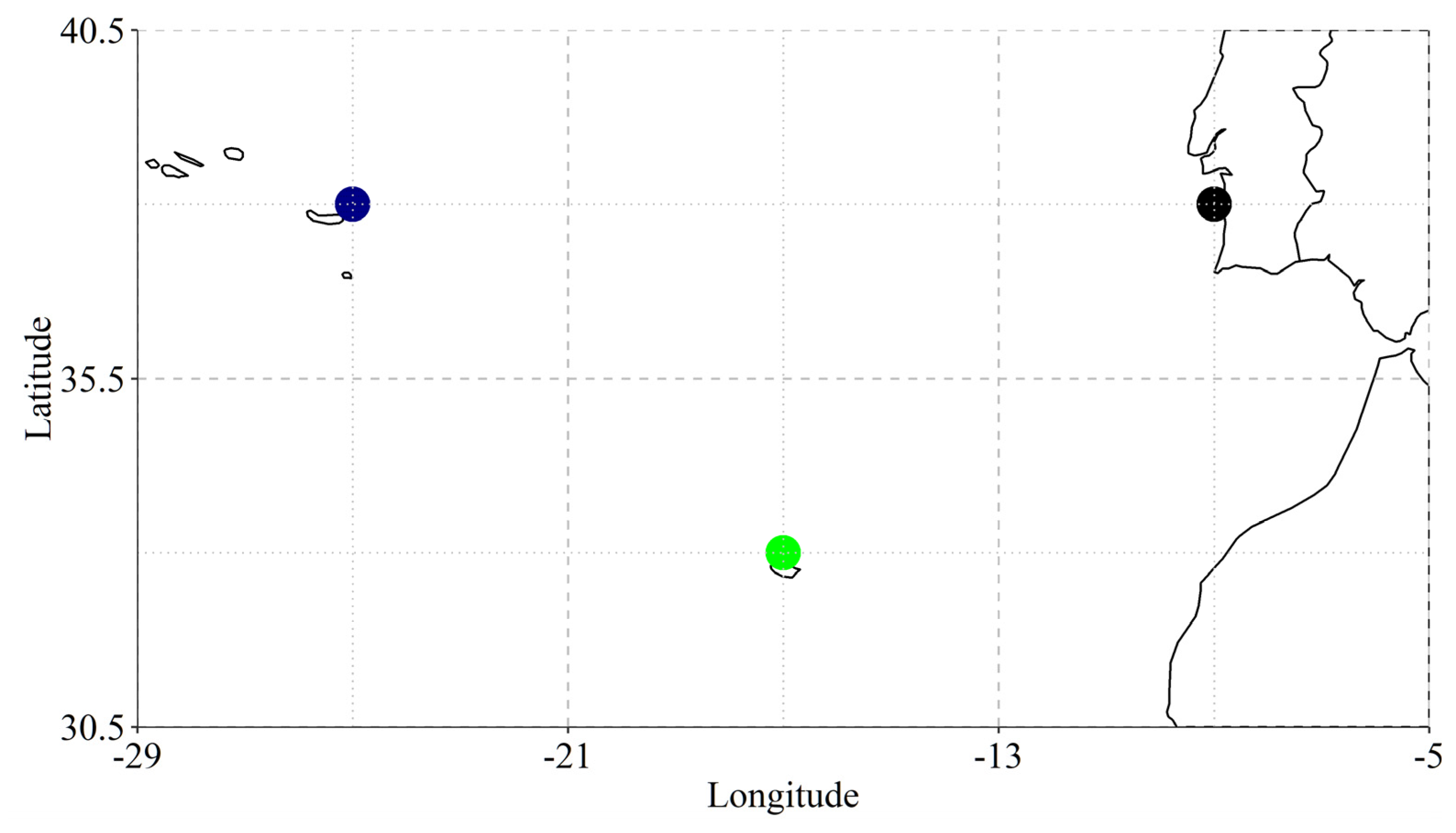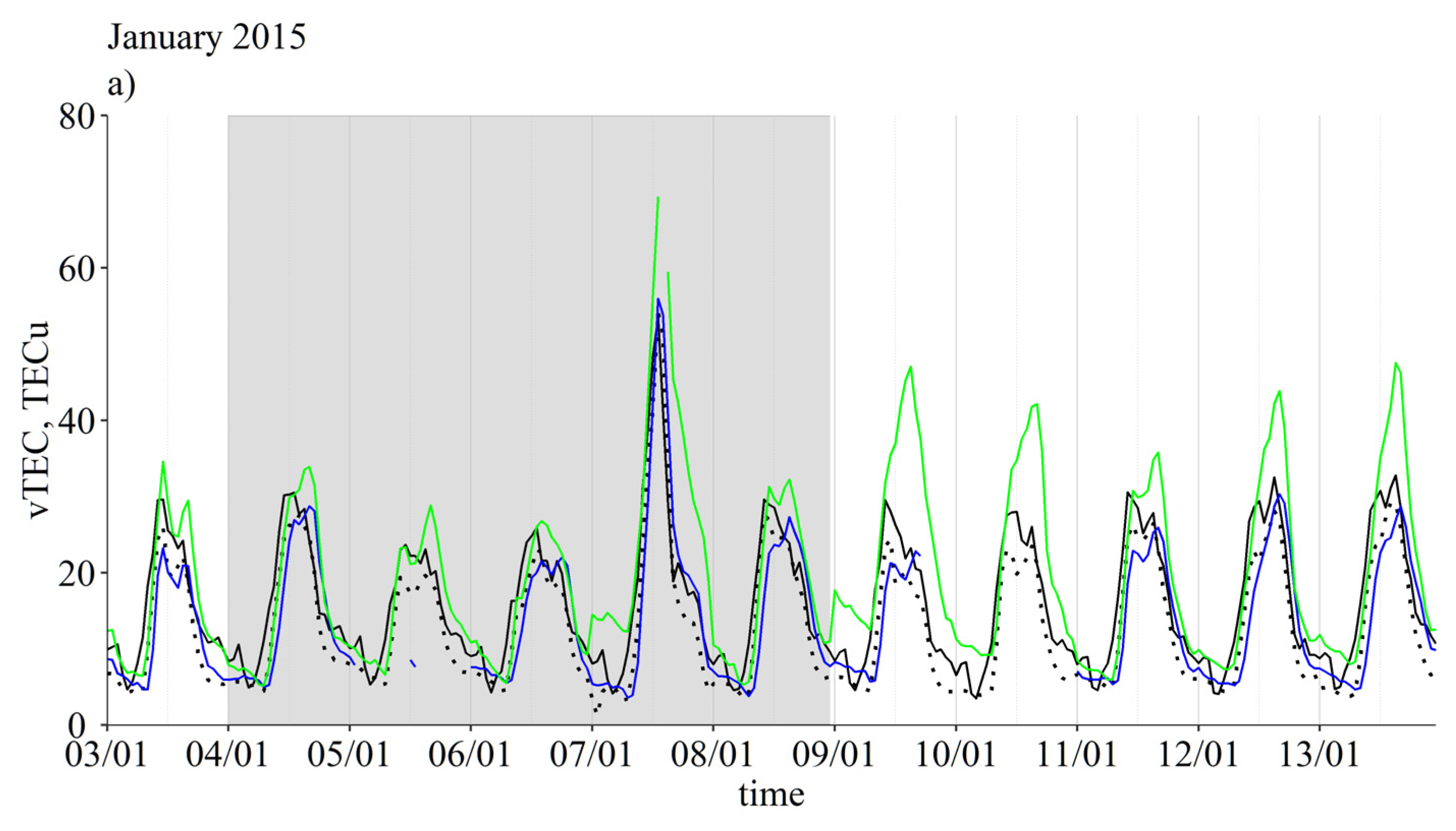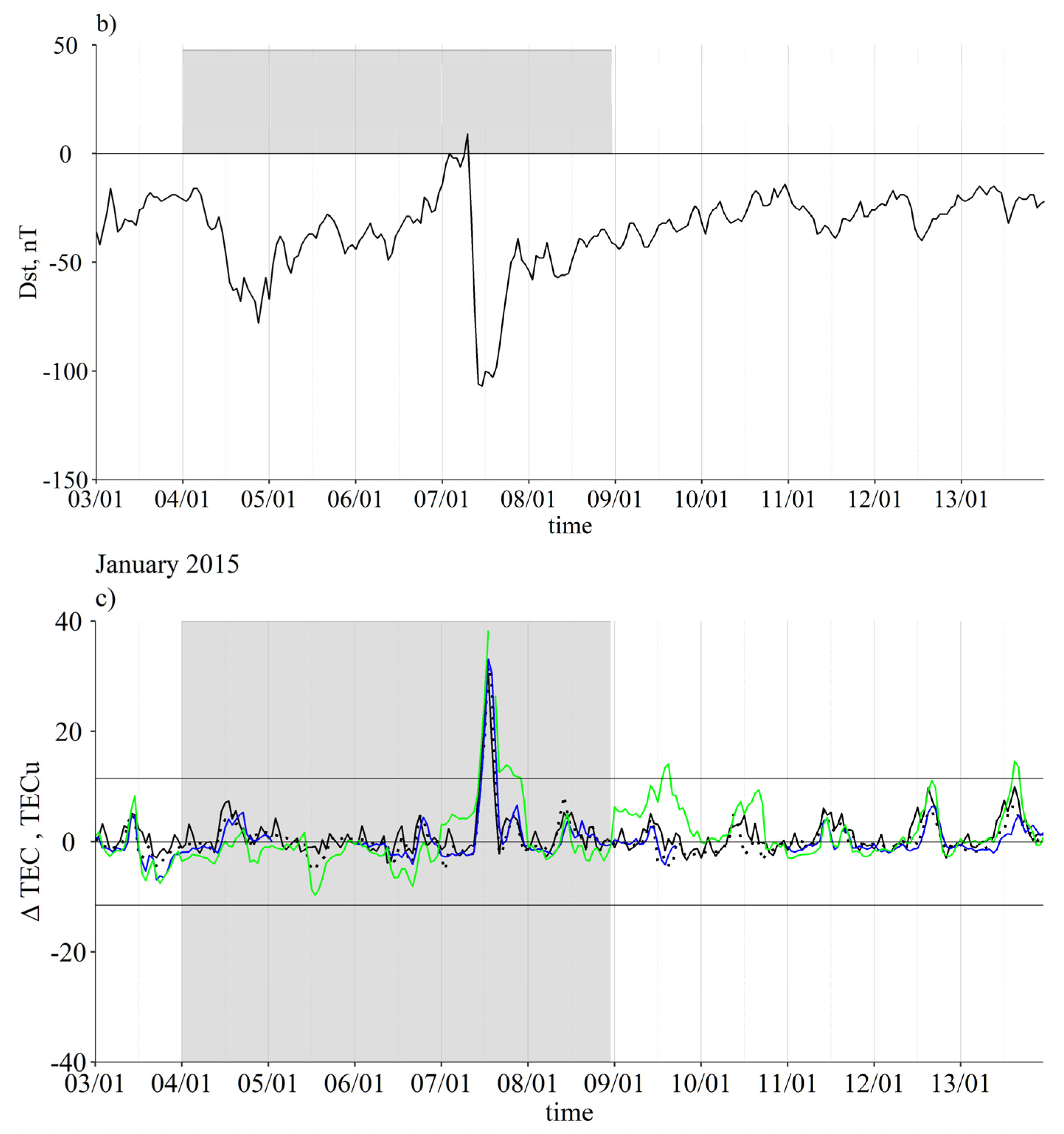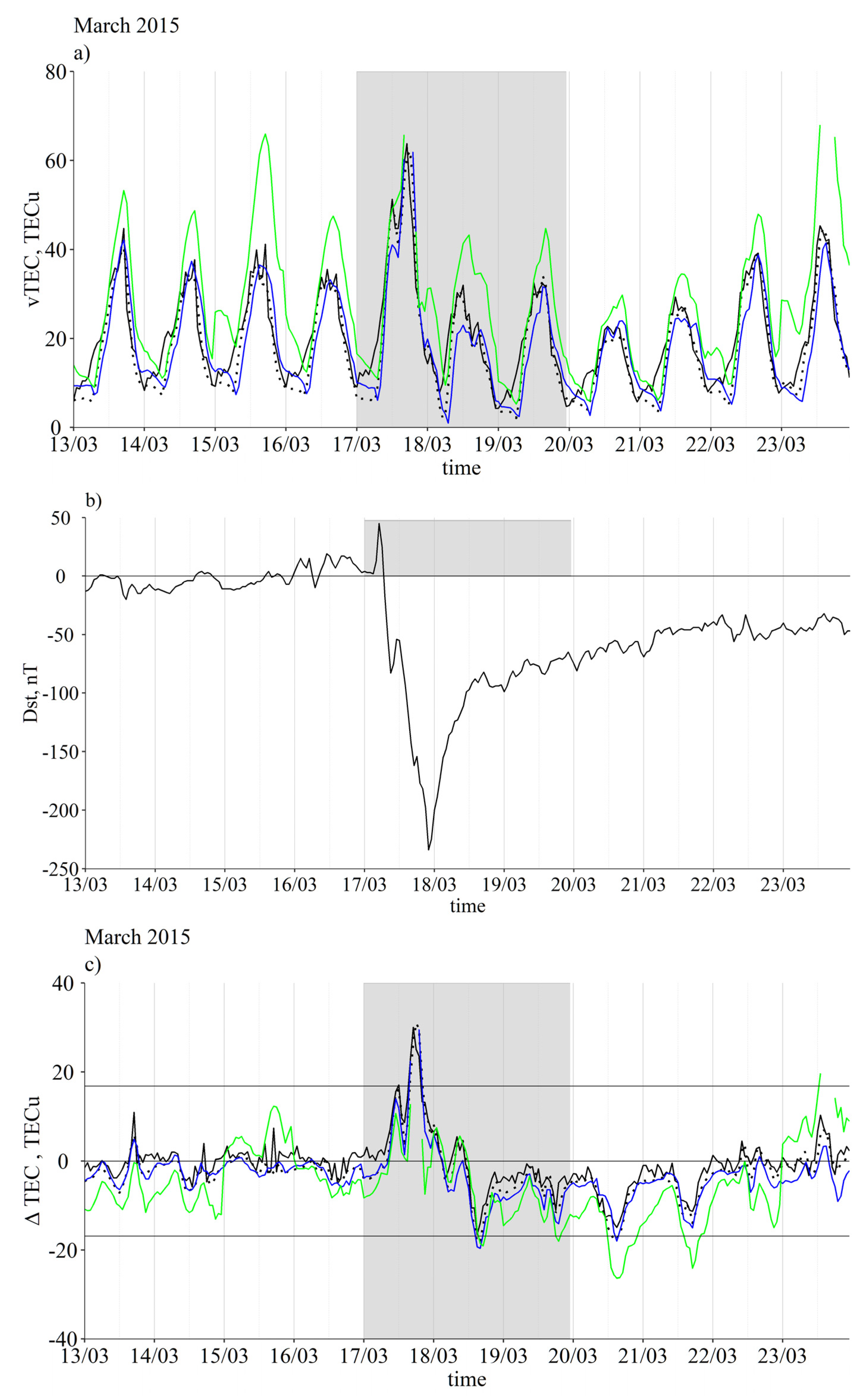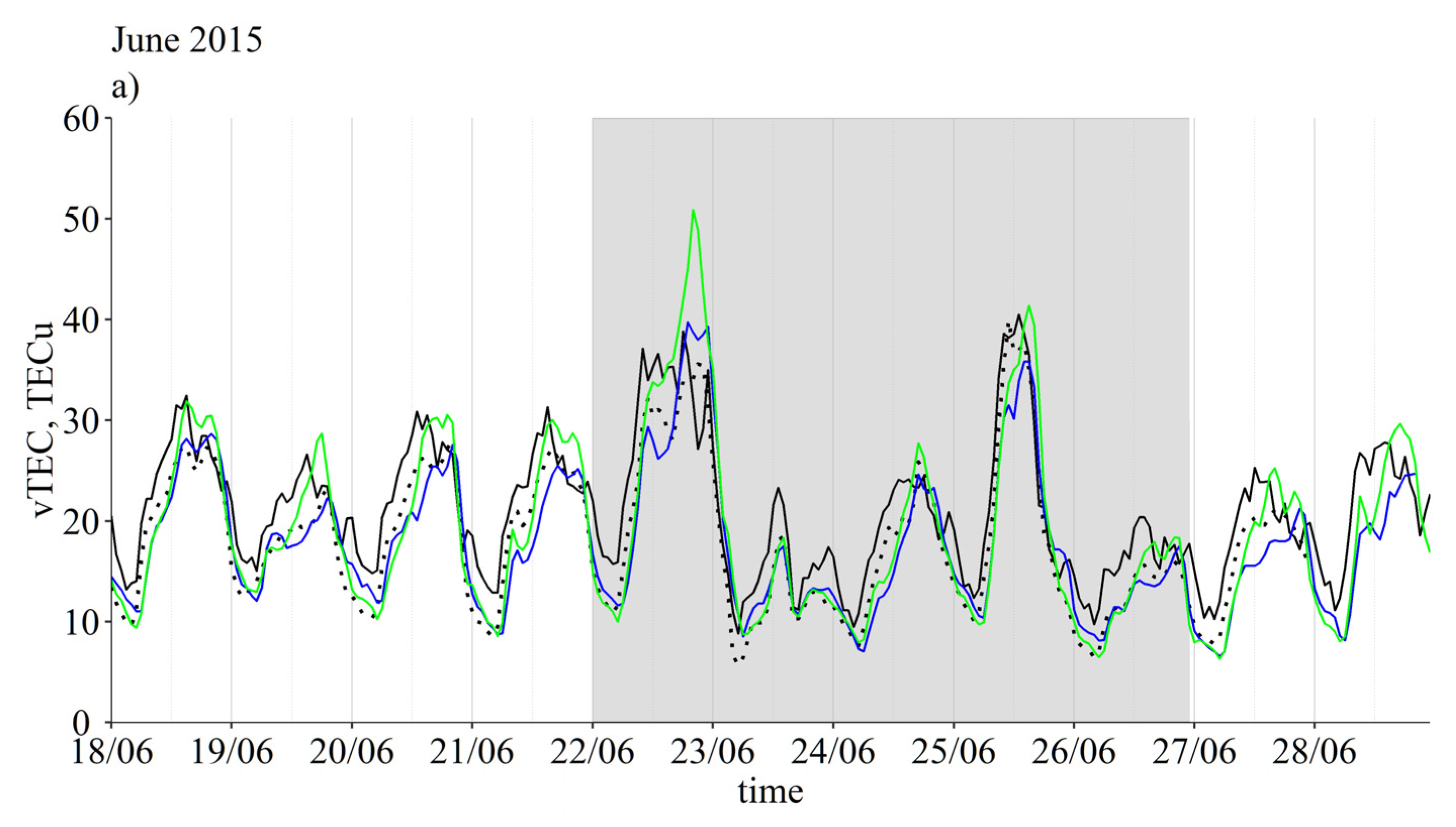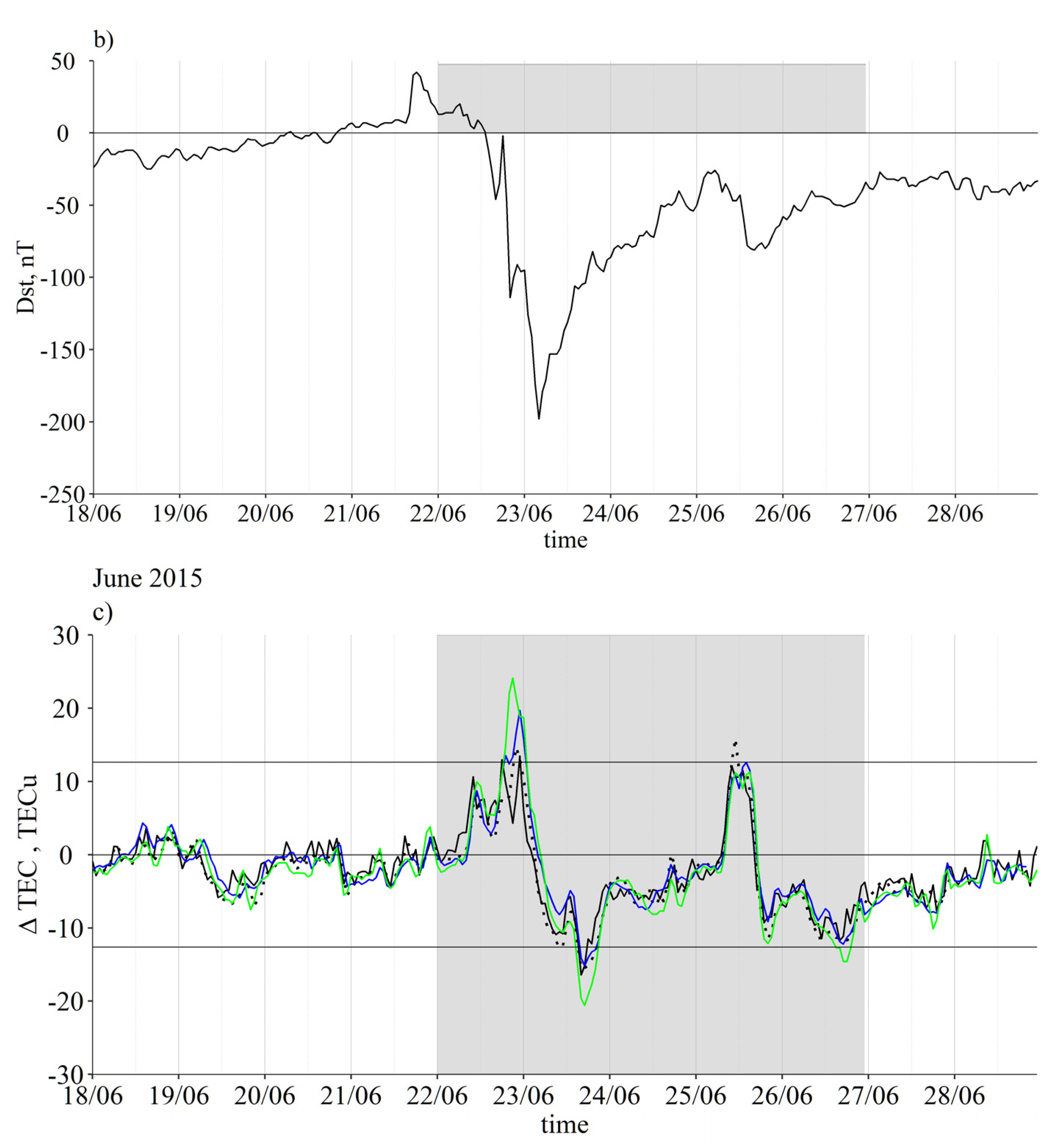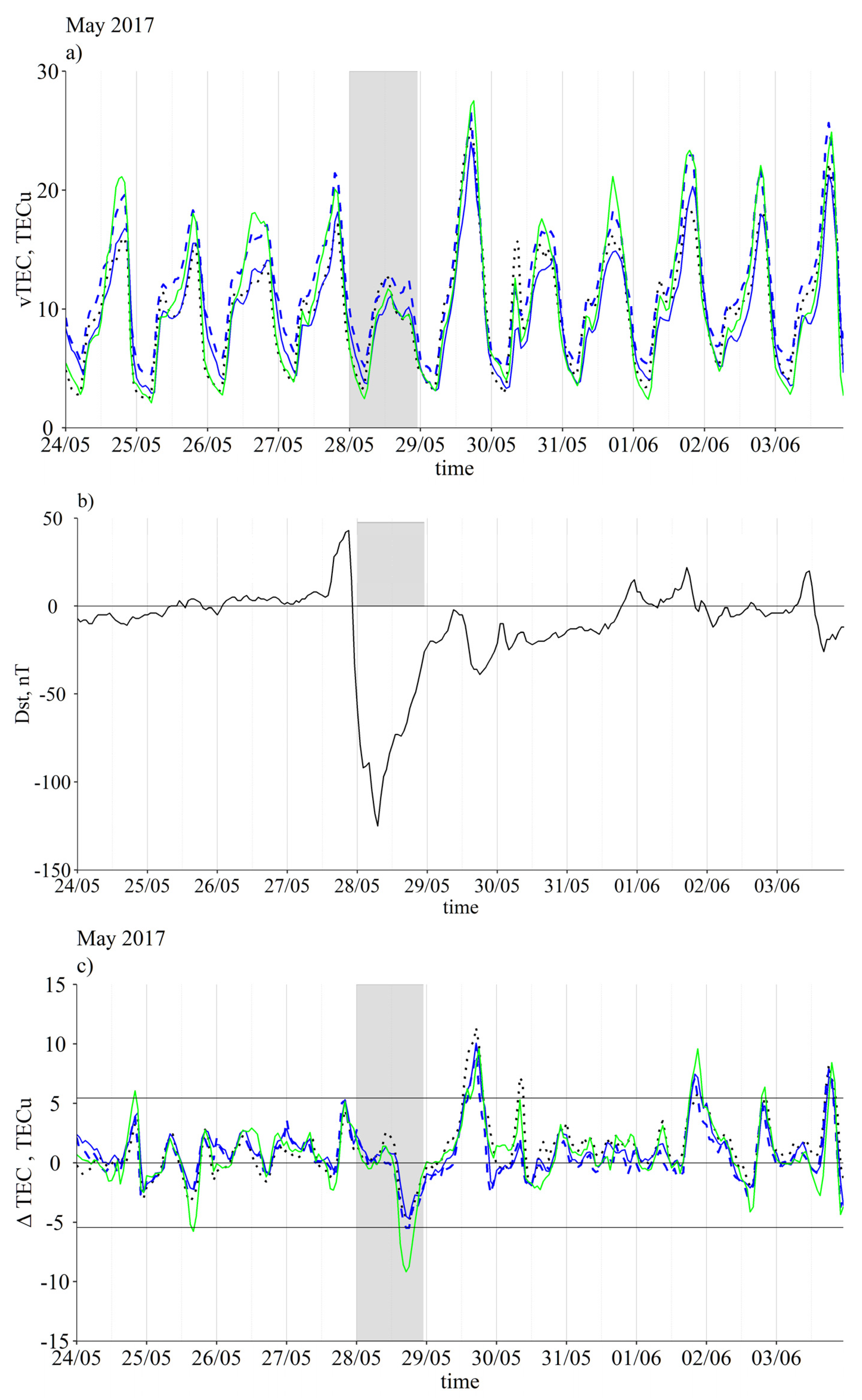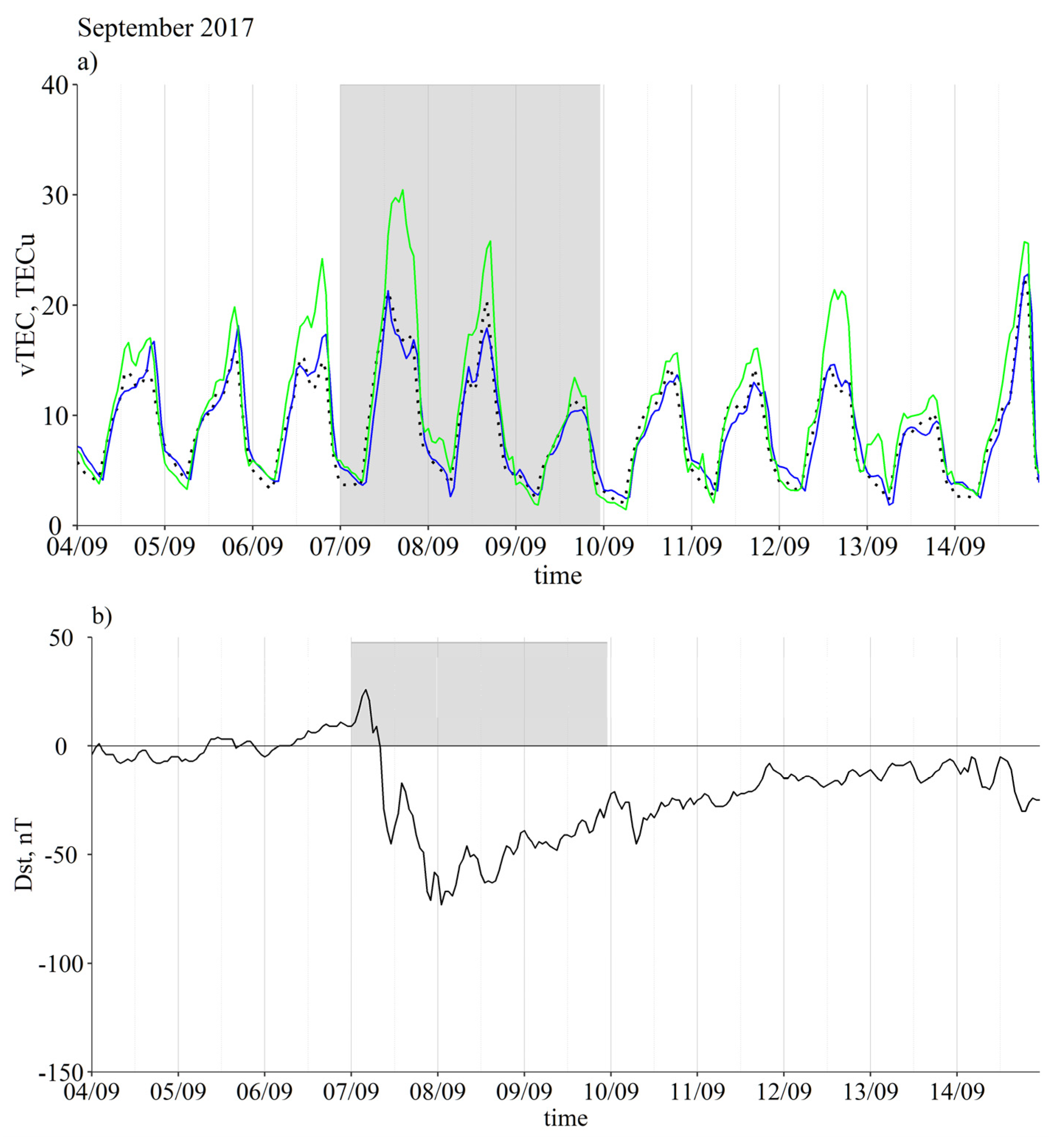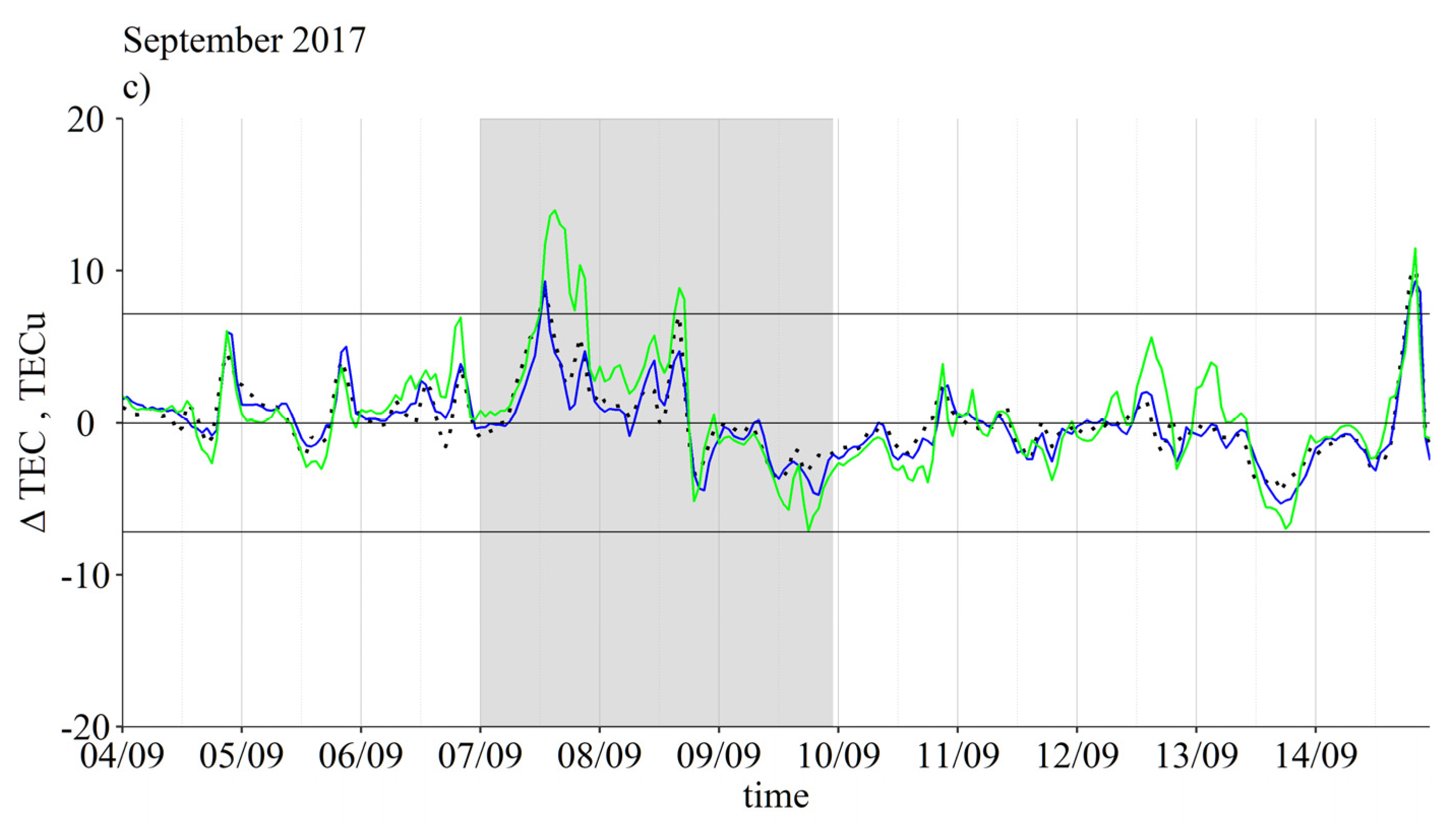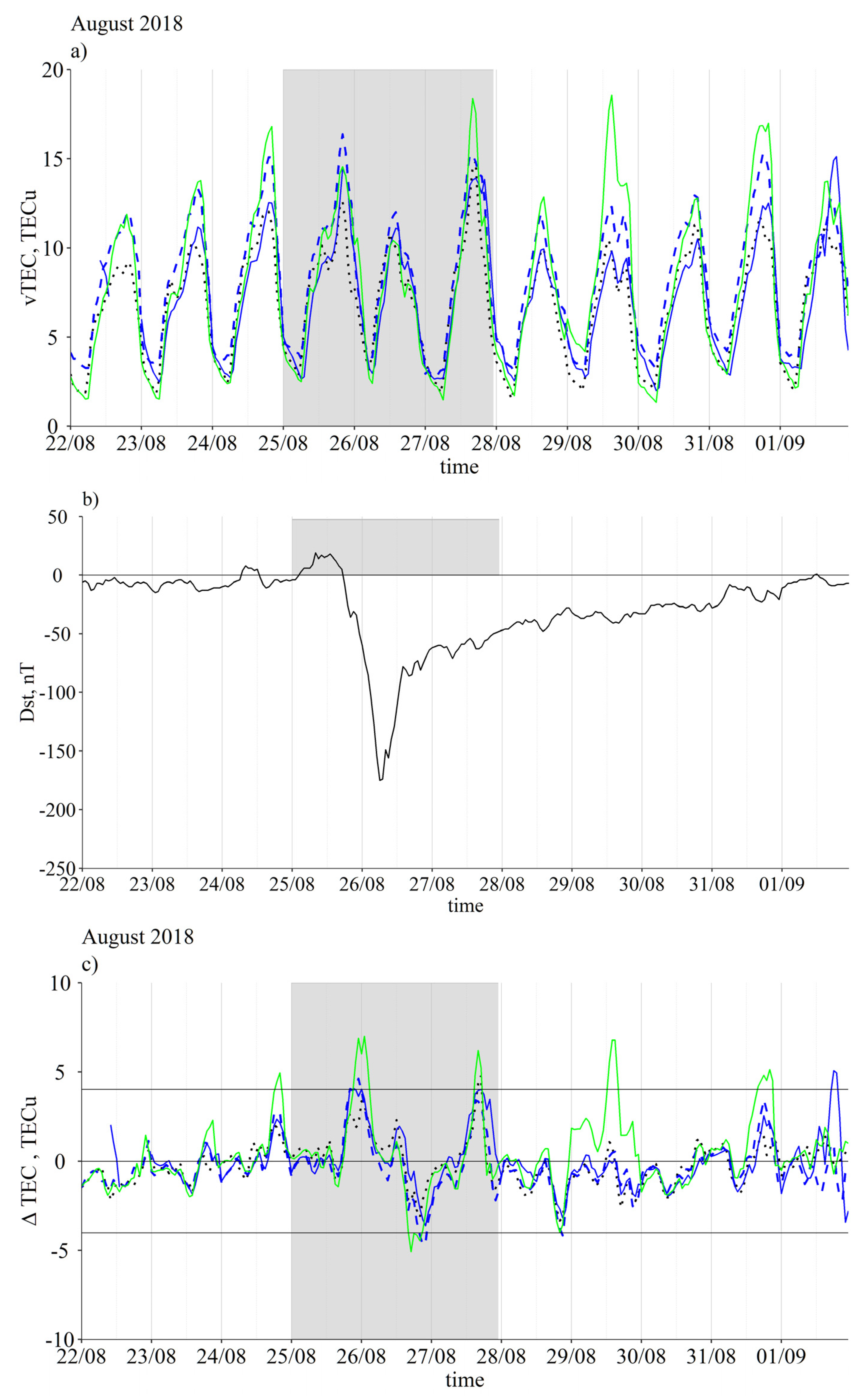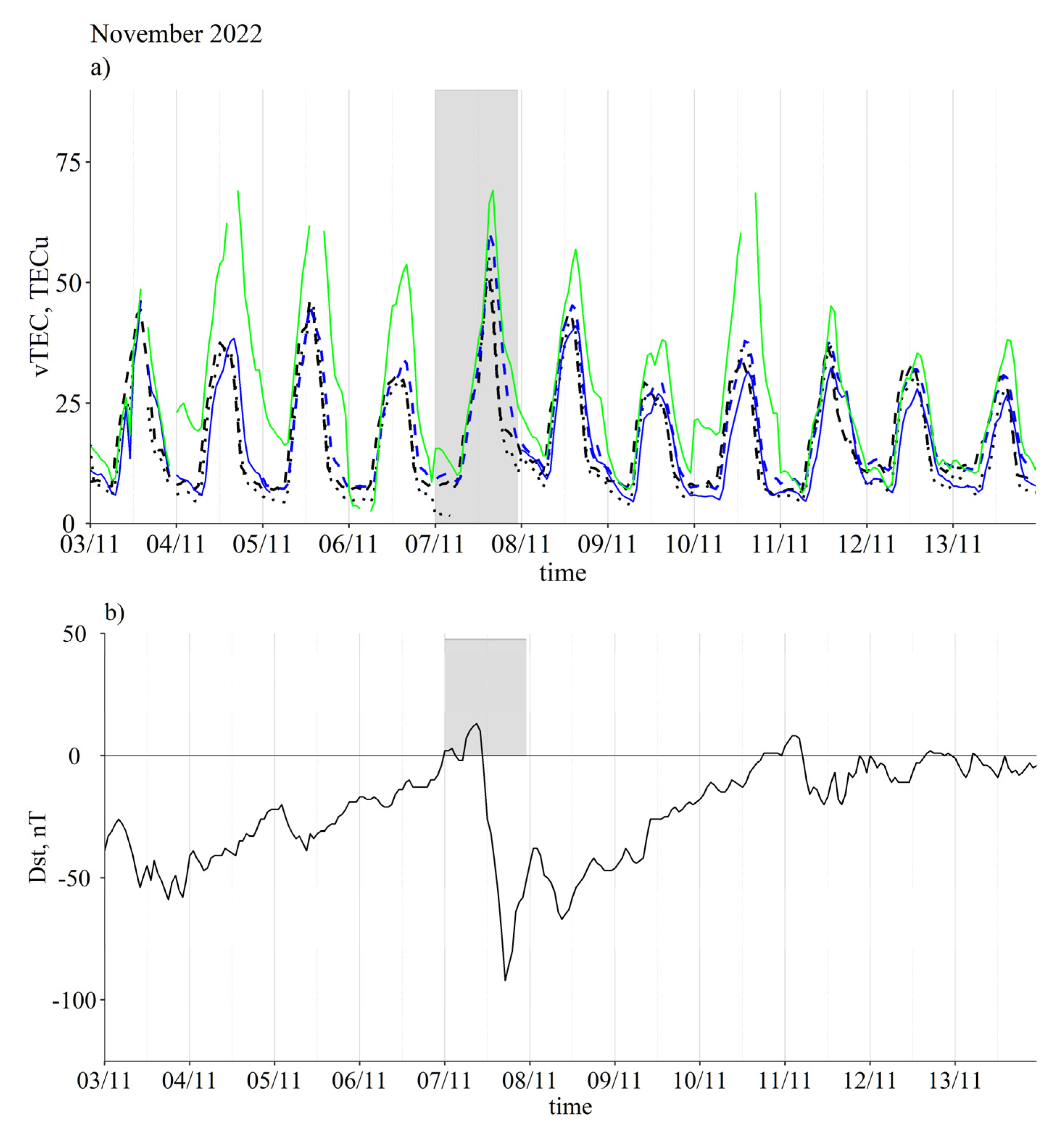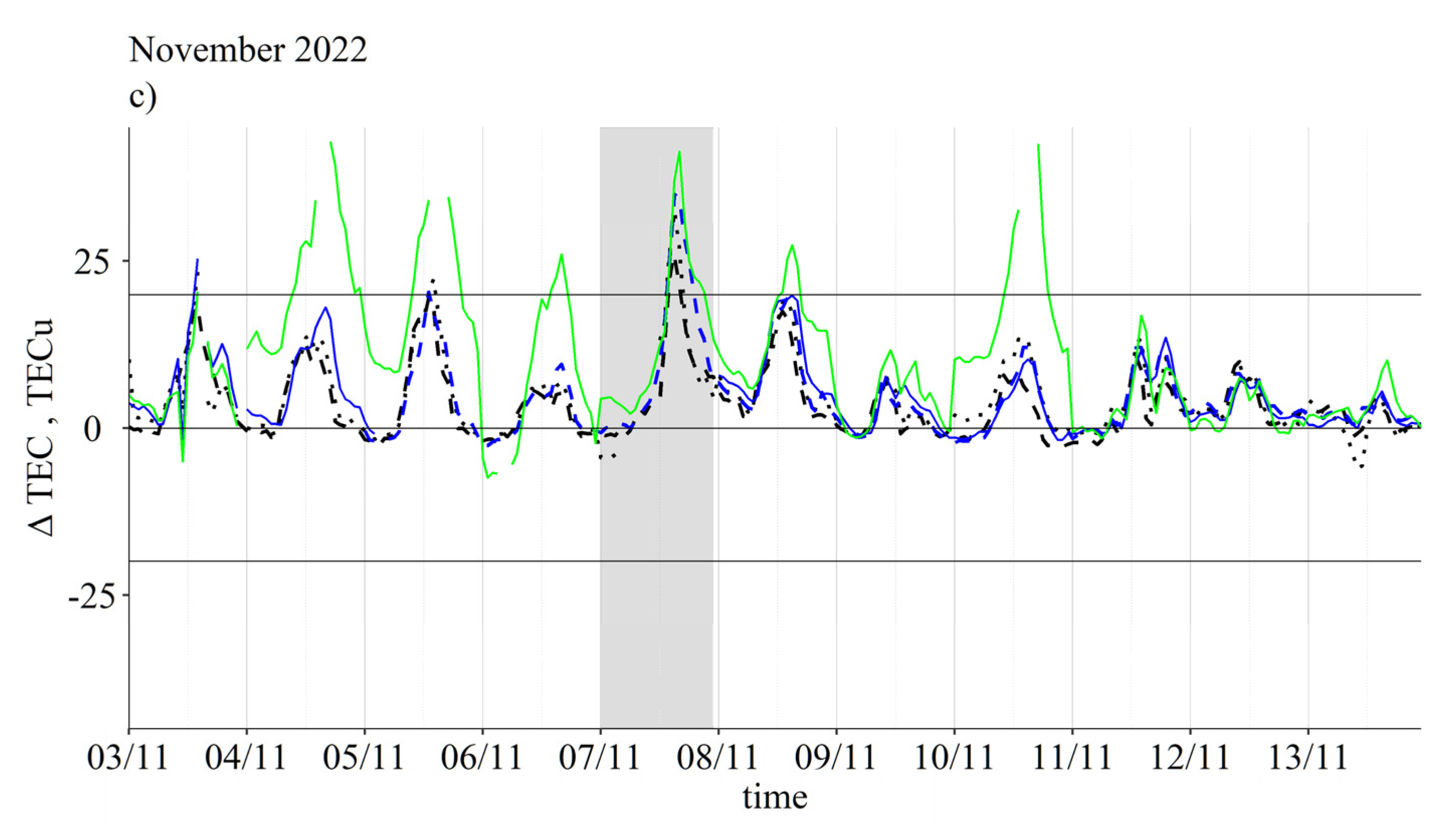1. Introduction
Our society increasingly depends on satellite-based services as communication, surveillance, navigation, and timing technologies [
1]. Space weather is one of the main drivers of ionospheric disturbances, which can affect conditions for propagation of electromagnetic signal from GNSS (Global Navigation Satellite System), communication and other types of satellites. Space weather effects on the ionosphere are notable at high and low latitudes and, for this reason, is extensively studied and described. However, as pointed out by [
2], based on historical surveys, the current state of knowledge of properties of ionospheric disturbances is biased for specific geographic regions, in particular for the middle latitude region.
The mid-latitude region comprises the latitudinal range between ~20° and 50° latitude, being considered until very recently devoid of significant ionospheric disturbances and irregularities [
3]. Advances in observational techniques and the increasing use of GNSS data to perform the Total Electron Content (TEC) measurements, which are widely used for ionosphere diagnostics, show that ionospheric disturbances at middle latitudes occur more often than previously thought [
2,
3,
4,
5,
6], including [
4], based on bibliographical research, where a brief review of ionospheric disturbances at mid-latitudes can also be found.
The strong effects of space weather at high latitudes on the ionosphere are due to specific geomagnetic field configurations that lead to the coupling of the magnetosphere and the polar ionosphere. At low latitudes, the space weather influence is mainly due to higher insolation (and, consequently, ionization) level, the presence of the equatorial electrojet (EEJ), a strong electric current in the ionosphere. All these factors lead to variations (spatial and temporal) of the electric and magnetic fields and associated convection of the upper atmosphere resulting in TEC fluctuations and scintillation events. The ionosphere at middle latitudes is affected by space weather events both directly and due to couplings with polar and equatorial regions [
4,
5,
8,
9,
10,
11].
Besides the latitude, other factors related with the ionospheric TEC fluctuations must also be considered, such as seasonal variation, longitude, time of the day, solar cycles, and geomagnetic activity [
12]. In [
13], a comparative analysis of studies related to the latitudinal or longitudinal dependences of ionospheric responses can be found. This work also focuses on the seasonal impact on the ionosphere and the global effect on TEC values along three meridians (American, Euro-African and Asian-Australian) based on six geomagnetic storms of different intensities to find similarities or differences in TEC response.
This work intends to contribute to the understanding of geomagnetic storm driven ionospheric disturbances at middle latitudes, in the longitudinal direction across the Atlantic Ocean from mainland Portugal to the Azores (~9ºW to ~26ºW, respectively) and at different latitudes (mainland Portugal and the Azores at ~40ºN versus Madeira at ~30ºN), through the comparative study of eight geomagnetic storms from 2015 to 2022. To the best of our knowledge, there are few studies for this region, despite being geographically very attractive since it is located on western borders of the coverage of the European Geostationary Navigation Overlay (EGNOS), the satellite-based augmentation system (SBAS) for GNSS (such as GALILEO).
The paper is structured as follows: section 2 describes the data and methods used in our analysis, section 3 refers the results obtained and section 4 gives a discussion with the main conclusions.
2. Materials and Methods
The ionospheric disturbances were studied for eight geomagnetic storms between 2015 and 2022, corresponding to the descending phase of the solar cycle 24, whose maximum was in 2014 and the beginning of the solar cycle 25, which started in December 2019.
2.1. Total Electron Content data
The TEC series were collected for three locations: Continental Portugal – area around Lisbon, the Azores archipelago – area around the Santa Maria and São Miguel islands, and the Madeira archipelago – area around Funchal city – see
Figure 1.
Figure 1.
Coloured circles show approximate location of GNSS receivers at the Continental Portugal (black), and the Azores (blue) and Madeira (green) archipelagos. Colours of the circles correspond to the colours of the lines in Figs. 2-9.
Figure 1.
Coloured circles show approximate location of GNSS receivers at the Continental Portugal (black), and the Azores (blue) and Madeira (green) archipelagos. Colours of the circles correspond to the colours of the lines in Figs. 2-9.
The TEC data are GNSS TEC data obtained from SCINDA and RINEX files. For the Lisbon location there were three data sources:
data from a GNSS receiver installed in the area of the Lisbon airport between 2014 and 2019. The data are available at [
14,
15] and described in [
16,
17]. Since the calibration procedure was not performed during the installation of this receiver a provisional calibration of the TEC records using TEC data from the Royal Observatory of Belgium (ROB) as a reference was performed as described in [
17] – hereafter Lis-SCINDA TEC;
data from a GNSS receiver installed in the same area during the SWAIR (
https://about.swair.ptech.io/) project (calibrated and in TECu) – hereafter Lis-SWAIR TEC;
For the Azores there were two data sources:
For Madeira there was one data source: data obtained from a RENEP receiver at Funchal – hereafter Mad-RENEP TEC.
Coordinates of all these receivers are shown in
Table 1.
Table 1.
Coordinates of GNSS receivers.
Table 1.
Coordinates of GNSS receivers.
| Location |
Latitude |
Longitude |
| Lis-SCINDA |
38.7ºN |
9.14ºW |
| Lis-SWAIR |
38.7ºN |
9.14ºW |
| Lis-RENEP |
38.7ºN |
9.4ºW |
| Az-RENEP |
37.8ºN |
25.3ºW |
| Az-RAEGE |
36.8ºN |
26.6ºW |
| Mad-RENEP |
32.7ºN |
16.9ºW |
RAEGE-Az provides data in the RINEX 3.0 format. These files were processed and calibrated using software developed by the UPC-IonSAT team [
21,
22]. This software allows to read RINEX 3.0 files to obtain ionospheric (geometry-free) combination of dual-frequency carrier phases L1-L2, download satellites RINEX 3 broadcast ephemeris files in SP3 format to calculate non-calibrated slant TEC (i.e., affected by the carrier phase bias) from each of the available satellite and receiver, and to use UQRG GIMs to calibrate slant TEC and calculate vertical TEC, from dual-frequency carrier phase measurements only.
TEC series for all the receivers were averaged to have 1h time resolution. Variations of TEC during geomagnetic storms were studied as differences between the observed TEC and the mean quite TEC variation: ΔTEC = TEC – TECQD. TECQD was calculated as an average daily TEC variation for quiet days (days without geomagnetic disturbances) of the given studied month. Only ΔTEC values exceeding the ±2σ limits were considered to be statistically significant, where σ is the maximum standard deviation for all available quite TEC series for a studied month.
2.2. Space Weather data
To identify and characterize geomagnetic storms we used the Dst geomagnetic index from the OMNI data base (https:/omniweb.gsfc.nasa.gov) with 1h time resolution. The geomagnetic storms were selected taking into account the availability of TEC data for all three locations and the strength of storms (only storms with min Dst < -90 nT were selected).
3. Results
As mentioned above, studies of TEC irregularities are mainly focused on the northern hemisphere at high latitudes, the equatorial region, and the South Atlantic Anomaly, with minor attention to European and North Atlantic middle latitudes. Also, relations between TEC variations of and position errors (or other faults) of GNSS systems are not always addressed [
23]. In this work we focus on the ionospheric response to geomagnetic storms at the North Atlantic middle latitude region (Portugal, Azores and Madeira) with emphasis on TEC variations and consequences for GNSS signal found in other studies and reports.
3.1. Geomagnetic storm of January 2015
The first storm of 2015 was a relatively strong storm (min Dst = -107 nT) that occurred on January 7, 2015. It was, most probably, related to a CME that occurred four days before, on January 3 [
24]. Other manifestations of the solar activity occurred in the following days, such as a coronal hole near the south pole and another at low latitudes in the northern solar hemisphere. The flare activity was considered medium, and on January 5 another CME occurred, but it is unlikely to be related to the storm [see 24]. The storm was preceded by weak geomagnetic disturbances on January 4-5 – see
Figure 2b.
At the region under study this geomagnetic storm caused an increase of TEC during January 7 by 30-40 TECu (
Figure 2a and 2c). The weak geomagnetic disturbances on January 3-4 had no strong ionospheric consequences (ΔTEC was inside ±2σ limits). The maximum ΔTEC values at Lisbon and Azores were approximately the same and lower by ~5 TECu than the maximum ΔTEC at Madeira. Also, ΔTEC at Madeira has a second increase in the afternoon hours of January 7, and also exceeded the 2σ limit on January 9, during the recovery phase of the storm. Also,
Supplementary Figure S1 shows animations of changes of the average ΔTEC (in σ units) for each location from January 6 to January 10 with 1h cadence.
As one can see, the ionospheric storm began on January 7 at 10h UTC, reached its maximum at 12h UTC and the ionosphere began to recover at around 16h UTC (except for Madeira). There were no significant ionospheric disturbances during January 8, but on January 9 small ionospheric disturbances of ~2σ for Lisbon-Azores and >2σ for Madeira were observed. Whether they are related to disturbances in the equatorial electrojet (EEJ) is not yet clear.
Figure 2.
Variations of TEC and Dst during January 2015. For this and similar plots (a) Variations of TEC measured at the three locations: Lisbon (black lines: Lis-SCINDA – solid line, Lis-SWAIR – dashed line, Lis-RENEp – dotted line), Azores (blue lines: Az-RAEGE – solid line, Az-RENEP – dashed line) and Madeira (Az-Madeira - green solid line). (b) Variations of Dst. (c) Variations of ΔTEC the three locations. Horizontal lines mark ±2σ limits for ΔTEC.
Figure 2.
Variations of TEC and Dst during January 2015. For this and similar plots (a) Variations of TEC measured at the three locations: Lisbon (black lines: Lis-SCINDA – solid line, Lis-SWAIR – dashed line, Lis-RENEp – dotted line), Azores (blue lines: Az-RAEGE – solid line, Az-RENEP – dashed line) and Madeira (Az-Madeira - green solid line). (b) Variations of Dst. (c) Variations of ΔTEC the three locations. Horizontal lines mark ±2σ limits for ΔTEC.
This storm provoked TEC fluctuations on January 7 at high latitudes, with the consequent degradation of the accuracy of GPS positioning, as reported by [
25].
3.2. Geomagnetic storm of March 2015
This storm, so called the St. Patrick's geomagnetic storm of 2015, occurred on March 17, 2015. It is very well described in literature (e.g. [
26,
27,
28,
29,
30]) since it was the most severe storm of the solar cycle 24 [
31]. TEC variations during this storm for the Iberian Peninsula were previously described in [
5]: this geomagnetic storm resulted in a positive-negative ionospheric storm (increase of TEC (positive ΔTEC) during the day of the storm and decrease of TEC (negative ΔTEC) during the following day). A comparison of the TEC variations for Lisbon, Azores and Madeira (
Figure 3a and 3c) shows that for all locations the TEC variations are synchronous, though the amplitude is higher for the most southern location – Madeira, probably due to the effect of EEJ.
Supplementary Figure S2 shows variations of an average ΔTEC (in σ units) for each location from March 16 to March 20 with 1h cadence.
The ionospheric storm started in the morning of March 17 first at Lisbon, then at Azores and Madeira. Maximum ΔTEC were observed in the afternoon of March 17 near and after the local sunset. TEC variations during the night were small but starting from midday of March 18 ΔTEC decreased below -2σ for all locations.
A fast recovery to the quiet level was observed on March 19, but on March 20 there was another decrease of TEC due to a partial solar eclipse that was observed at this region around 09:00 UT with the maximal obscuration of 60% at Lisbon, 65% at Madeira and 70% at Azores. This eclipse or, more precisely, the atmospheric gravity waves generated by the Moon’s shadow passing through the atmosphere caused traveling ionospheric disturbances (TIDs) occurring over Europe [
32,
33,
34]. The results of our analysis support a conclusion of [
33] that the recovery of the ionization rate was faster at higher latitudes: as one can see from
Figure 3c: ΔTEC at Madeira (~30ºN) was larger in the absolute values and recovered slower comparing to TEC at ~40ºN (Lisbon and Azores).
Figure 3.
Variations of TEC and Dst during March 2015 (see detailed description in
Figure 2).
Figure 3.
Variations of TEC and Dst during March 2015 (see detailed description in
Figure 2).
One of several examples of the impact of this storm on GNSS systems can be found in [
35]. Based on measurements of 15 reference stations from the ASG-EUPOS network (Poland), the results have found degradation of the position quality determined by GNSS and decreased GNSS accuracy due to ionospheric perturbations in Central Europe. Strong GNSS disturbances with reflexes on positioning errors were detected in Norway [
36]. Those examples are supported by the study of [
37], based on 5,500 GNSS stations installed worldwide. The results show that the overall impact on GNSS positioning was more severe at high latitudes and related to ionospheric plasma irregularities. At low latitudes, the degradation was associated with various ionospheric disturbances, such as the equatorial ionosphere anomalies.
3.3. Geomagnetic storm of June 2015
The second strongest geomagnetic storm of cycle 24
was due to three consecutive CMEs, the first two associated with a filament and the third with a solar flare of the M2.6 intensity [
38]. The severe storm of June 23, 2015, was studied globally based on TEC values of GIMs, COSMIC radio occultation and IGS stations [
39]. During the initial period of the storm, the response of the ionosphere was asymmetric concerning the hemispheres, mainly due to seasonal effects, with a negative phase of the storm observed in most of the northern hemisphere and a positive phase in the southern hemisphere and western longitudes of the northern hemisphere, over the North Atlantic Ocean. The effect of this storm on TEC for the Iberian Peninsula was also described in [
5]
.
This ionospheric storm was caused by a two-fold geomagnetic storm with the main Dst decrease on June 22-23 and a secondary decrease on June 25 – see
Figure 4b. As a result, two positive-negative ionospheric storms were observed on June 22-23 and June 25-26, respectively (Figs. 4a and 4c, and supplementary
Figure S3). The amplitude of ΔTEC was above 2σ (in absolute values) for the main storm and about 2σ for the secondary storms for all studied locations. No significant differences in the ionospheric behaviour at different latitudes and longitudes were found.
As was reported in [
40]
, post-sunset equatorial plasma bubbles were generated and reached ~30-45ºN at the European sector during this geomagnetic storm. It seems that the sharp increase of TEC (Figure 4a and 4c) observed at all three locations in the late evening of June 23, and most strongly at Madeira, is related to this set of plasma bubbles.
Figure 4.
Same as
Figure 2 but for June 2015.
Figure 4.
Same as
Figure 2 but for June 2015.
These geomagnetic and ionospheric storms caused problems with the precision of the GNSS positing well described in [
41]. This study also covers GNSS positioning deteriorations during the St. Patrick's storm of 2015 and the geomagnetic storm of August 2018 (Greenland region only) described below.
3.4. Geomagnetic storm of May 2017
An Earth-directed CME on May 23, 2017, resulted in a geomagnetic storm from May 27 to May 29, initially due to fast changes in solar wind speed and pressure increase at the shock front [
42].
Contrary to the storms of 2015 discussed above, the ionospheric storm of May 28-29 was a negative-positive storm. This, probably, is because the geomagnetic storm commencement took place on the late evening of May 27 and the geomagnetic storm was already well developed to the local morning hours of May 28 (
Figure 5b) resulting in a strong decrease of TEC during this day: ΔTEC were ~-2σ for Lisbon and Azores and <-2σ for Madeira – see
Figure 5a and 5c, and supplementary
Figure S4. On the following day the ΔTEC was above +3σ for all three locations.
An interesting event was observed in the morning of May 30: a sharp increase of TEC between 08:00 and 09:00 UTC was observed at all three locations, but only for Lisbon and Madeira it reached the threshold of 2σ. As one can see from
Figure 5c, almost all days between May 25 and June 3 had small “jumps” in TEC at about these hours, but only on May 30 and only for Lisbon and Madeira locations these “jumps” were of a significant amplitude. We suppose that these TEC variations are not related to a storm effect (the geomagnetic conditions were quiet on May 30, see
Figure 5c) but caused by post-sunset equatorial plasma bubbles that survived until the morning hours and went too northward during those days, similarly to the case of the late evening of June 22, 2015 (
Figure 4c).
Figure 5.
Same as
Figure 2 but for May 2017.
Figure 5.
Same as
Figure 2 but for May 2017.
The study performed by [
43] based on in situ and satellite observations (Swarm B and DMSP F15&16) of this storm revealed structures corresponding to a plasma blob over the Asian sector. The Earth-directed CME reached Earth on May 27, and after the impact, it caused two more episodes. On [
44], the authors reported a range error of 1.6-3.2 m at the GPS (Global Position System) L1 frequency during the quietest periods of the storm (20-10 TECu) and a 37 m range error at the GPS L1 frequency for 20-45 TECu values over the India sector [
44]. These values demonstrate the degradation of the performance of GNSS receivers, which is critical for many GNSS applications.
3.5. Geomagnetic storm of September 2017
At the beginning of September of 2017 (starting from September 3) the active region NOAA 2673 increased its activity, being the origin of several solar M flares, radio bursts and CMEs. The geomagnetic storm started at early hours of September 7 and lasted until September 9 (Dst remained below the -50 nT limit) -
Figure 6b.
The ionospheric response to this storm in the studied region consisted of a strong positive ionospheric storm on September 7 (ΔTEC ≥ 2σ at all studied location) and a weak positive ionospheric storm on September 8 seen at Lisbon and Madeira (ΔTEC for the Azores did not reach the 2σ limit) – Figs. 6c and S05. Also, on September 7 there was an afternoon increase of TEC with ΔTEC < 2σ for Lisbon and Azores (~40º N) and ΔTEC > 2σ for Madeira (~30ºN). On the third day of the storm, September 9, a negative ionospheric storm took place but with a small amplitude |ΔTEC| ≤ 2σ (Figs. 6a and 6c).
Figure 6.
Same as
Figure 2 but for September 2017.
Figure 6.
Same as
Figure 2 but for September 2017.
On September 6, the Earth-directed CME from an X9.3 flare provoked ionospheric disturbances with consequences for the EGNOS system and GNSS receivers [
45]. During this event, the availability of EGNOS was reduced by 10%, with limited usage for the safety of life applications, such as services to aviation, maritime, and land-based users [
45]. In this paper the authors describe other examples of how ionospheric perturbations have an impact on GNSS systems, such as the loss of GNSS receivers with links to the GNSS satellite (designated by the loss of lock) and the Automatic Identification System (AIS), an automatic tracking system to improve the safety at sea. In Svalbard, the effect on the GPS positioning was also evaluated and reported in [
46]: due to this ionospheric storm significant increments of the positioning error were observed during scintillation events. Signal interferences on ground GNSS stations for the European longitude sector (20°N to 70°N) affecting the GNSS single and the dual positioning for Galileo, GLONASS and GPS were also studied in [
47]: the dual frequency systems were the most affected ones.
Plasma bubbles are ionospheric phenomena typical over equatorial and low latitudes. However, as we discussed above, recent studies, e.g., such as those in [
9], suggest that plasma bubbles can extend to other regions, such as middle latitudes. In these cases, the Travelling Ionospheric Disturbances (TID) could play a role in enabling the latitudinal extension of the bubbles. As demonstrated by the authors in [
9], during this storm, the TIDS facilitated the latitudinal extension of the bubbles over China and adjacent areas (20º–45ºN and 80º–110ºE). Another example TID influence, but of different origin, was found in [
48] where fluctuations on TEC indicate TID propagation from high latitudes to lower latitudes.
3.6. Geomagnetic storm of August 2018
This geomagnetic storm was provoked by a CME that occurred on August 20, 2018, and impacted the Earth on August 25 during the daytime, but only in the late afternoon the Dst index started to drop reaching its minimum of -175 nT around 06:00 UTC of August 26 –
Figure 7b. As a result, TEC variations in the studied region during August 25 (see Figs. 7a, 7c and S06) were insignificant until afternoon of August 25, but then rapidly increased and reached maximum around midnight August 25-26 (a positive storm with ΔTEC ≥ 2σ for Azores and Madeira and ΔTEC < 2σ for Lisbon). On the following day, August 26, the ionospheric storm was a negative one (|ΔTEC| > 2σ for Azores and Madeira and |ΔTEC| < 2σ for Lisbon), however, on August 27, there was another positive ionospheric storm with ΔTEC > 2σ for all three locations. ΔTEC variations observed for Madeira on August 29 and 31, to our mind, are not related to the geomagnetic storm directly but caused by disturbed conditions in EEJ.
Figure 7.
Same as
Figure 2 but for August 2018.
Figure 7.
Same as
Figure 2 but for August 2018.
As reported in [
49], from August 25 to August 26 intense ionospheric irregularities occurred in the equatorial region, observed at both sides of the equator, and extended considerably to higher latitudes (40°–45°). Considering the study by [
50], the TEC increase for middle latitudes was more significant in the southern hemisphere (Africa) than in Europe.
Despite the intensity of ionospheric disturbances and the significant increase in electron density recorded, especially in the storm's main phase, no loss of lock or other problems were reported for any of the GNSS systems. In terms of impact on GNSS navigation systems, this corresponds to a weak space weather event, contrary to what occurred to the geomagnetically induced currents, whose effects were strong [
51].
3.7. Geomagnetic storm of November 2021
This geomagnetic storm is considered to be the first geomagnetic storm of the solar cycle 25. It provoked ionospheric variations with latitudinal and longitudinal dependences in Europe [
52]. Several C and M flares occurred during the November 1, 2021, leading to a CME on November 2. The geomagnetic event was a short-living storm that lasted just one day of November 4 –
Figure 8b.
The ionospheric response in the studied region can be classified as a 2-day-long (November 4 and 5) positive ionospheric storm that was observed at all three locations with ΔTEC > 2σ for Lisbon and Madeira and ΔTEC < 2σ for Azores (see Figs. 8b, 8c and S07). Also, in the afternoon hours of November 4 a secondary TEC maximum was observed (< 2σ) at all three locations. The TEC variations observed during this storm at all three locations were synchronous.
Figure 8.
Same as
Figure 2 but for November 2021.
Figure 8.
Same as
Figure 2 but for November 2021.
To our knowledge, no disturbances in the GNSS signal were reposted for this storm.
3.8. Geomagnetic storm of November 2022
Due to a M5.2 flare and following disturbances in the solar wind that occurred on November 7, 2022, a geomagnetic storm started in the morning hours of November 7 and the Dst minimum of -92 nT was registered around 18:00 UTC –
Figure 9b.
As a result, a 2-day-long positive ionospheric storm has been developed at the studied region (Figs. 9a, 9c and S08) with ΔTEC > 2σ on November 7 at all locations and on November 8 only at Madeira (ΔTEC ≤ 2σ at Lisbon and Azores). This geomagnetic storm has been preceded by several days of a disturbed geomagnetic field (November 3-5) with Dst ≈ -50 nT. These disturbances may be a source of TEC variation observed on November 3-5 at all locations but most prominently at Madeira.
Figure 9.
Same as
Figure 2 but for November 2022.
Figure 9.
Same as
Figure 2 but for November 2022.
This minor storm provoked perturbations in the SBAS systems: EGNOS for GALILEO and the Wide Area Augmentation System (WAAS) for GPS. Significant disturbances affected some services provided by both systems. In Europe, EGNOS availability was reduced over Scandinavia and for America the WAAS availability affected Canada [
53].
4. Discussion and Conclusions
Ionospheric response to eight geomagnetic storms with Dst < -90 nT between 2015 and 2022 was studied for a mid-latitudinal region of the eastern North Atlantic: Lisbon at the Continental Portugal, and Madeira and Azores archipelagos (i.e., between 32ºN and 39ºN in latitudes and between 27ºW and 9ºW in longitude). GNSS-based total electron content (TEC) data were used to characterise ionospheric conditions.
For most of the studied geomagnetic storms the induced TEC variations during the day of a storm are synchronous for all three studied locations despite of an about 1h difference in the local (solar) time. On the other hand, in some cases ionospheric disturbances were observed first at the most eastern part of the studied region (Lisbon, or Lisbon and Madeira) and then the TEC variations “travelled” westward to Azores with a delay of about 1 hour.
In many studied cases the amplitude of TEC variations at Madeira was larger than in other two location, probably due to its lower latitude and, as a result, a proximity to the equatorial electrojet. Also, for some storms (e.g., June 2015 and May 2017) features that may be related to a northward transition of post-sunset equatorial plasma bubbles were observed.
For some of the storms, there are differences in the ionospheric response between the west (Azores) and east (Lisbon and Madeira) parts of the studied region (e.g., storms of May 2017 and November 2021).
For some of the storms there are differences (not just in the amplitude of TEC variations but in an appearance of certain features) in the ionospheric response between the northern (Azores and Lisbon) and southern (Madeira) parts of the studied region (e.g., storms of January and March 2015).
Almost all the studied geomagnetic storms caused positive or positive-negative ionospheric storms.
Two of the eight studied geomagnetic storms (May 2017 and August 2018) started during the local night-time and resulted in negative-positive ionospheric storms. More studies are needed to confirm or discard this probable relation between the ionospheric storm type and the time of the geomagnetic storm commencement.
There is no clear dependence between the strength of a geomagnetic storm and the strength and the type of a following ionospheric storm, and appearances of different type of discontinuities in the work of GNSS systems. Even that six out of eight (75%) studied storms were accompanied by reports of different kinds of failures in one or many of the operational GNSS systems, some of the storms were nevertheless completely “invisible” from the GNSS point of view (as, for example, the storm of November 2021). We believe that this ambiguity is due to the lack of systematic and uniform collection and analysis of data on the GNSS systems failures.
Supplementary Materials
The following supporting information can be downloaded at:
Preprints.org: Figures S1-S8: Animations showing average ΔTEC variations (in σ units – semi-transparent colour scale) for the studied locations for each of the analysed storms. Figures S1 – January 2015, S2 – March 2015, S3 – June 2015, S4 – May 2017, S5 – September 2017, S6 – August 2018, S7 – November 2021, S8 – November 2022. Non-transparent grey – no data.
Author Contributions
This work has the following contributions: conceptualization - A.M.; methodology - A.M. and Te.B.; software -, A.M., M.P., Ta.B.; validation - A.M., J. P.; formal analysis - A.M..; investigation - A.M., J.P., Ta.B. Te.B., M.P..; resources - A.M., Te.B.; data curation - A.M., Ta.B.; writing—original draft preparation, T.B..; writing—review and editing, T.B., A.M., J.P., M.P..; visualization, AM..; supervision, A.M..; project administration, A.M..; funding acquisition, A.M. All authors have read and agreed to the published version of the manuscript.
Funding
IA is supported by Fundação para a Ciência e a Tecnologia (FCT, Portugal) through the research grants UIDB/04434/2020 and UIDP/04434/2020.This study is a contribution to the PRIME project (EXPL/CTA-MET/0677/2021, FCT, Portugal) and JP is supported by this project.
Institutional Review Board Statement
Not applicable
Informed Consent Statement
Not applicable
Data Availability Statement
The Dst index is available at the Kyoto World Data Center: http:/wdc.kugi.kyoto-u.ac.jp/dst_final/index.html.
Acknowledgments
The authors would like to acknowledge the Direção Geral do Território (DGT) for making ReNEP data available, to A-RAEGE-Az for providing data from the RAEGE stations, as well as the people involved, Helena Ribeiro e João Ferreira. The authors a are grateful to Dr. Yuri Yasyukevich and his team for development of the GNSS Lab software and a technical support.
We acknowledge the research infrastructure and the access provider UPC-IonSAT of the PITHIA-NRF project (
https://www.pithia-nrf.eu/). The PITHIA-NRF project has received funding from European Union's Horizon 2020 research and innovation programme under grant agreement No 101007599.
Conflicts of Interest
The authors declare no conflict of interest.
References
- Kumar, V.; Parkinson, M. L. A global scale picture of ionospheric peak electron density changes during geomagnetic storms. Space Weather 2017, 15,637–652. [CrossRef]
- Mrak, S. GNSS remote sensing of space weather at mid-latitudes: Ionospheric irregularities and source analysis. PhD thesis, Boston University College of Engineering, Boston, 2020.
- Rodrigues, F. S.; Socola, J. G.; Moraes, A. O.; Martinis, C.; Hickey, D. A. On the properties of and ionospheric conditions associated with a mid-latitude scintillation event observed over southern United States. Space Weather 2021, 19, e2021SW002744. [CrossRef]
- Basu, S; Makela, J. J.; MacKenzie, E.; Doherty, P.; Wright, J. W.; Rich, F.; Keskinen, M., J.; Sheehan, R. E.; Coster, A. J. Large magnetic storm-induced nighttime ionospheric flows at midlatitudes and their impacts on GPS-based navigation systems. J. Geo Res: Space Phys. 2008, 113, A3. [CrossRef]
- Morozova, A.; Barlyaeva, T.; Barata, T. Variations of TEC over Iberian Peninsula in 2015 due to geomagnetic storms and flares. Space Weather 2020, 18 (11). [CrossRef]
- Cherniak, I.; Zakharenkova, I. First observations of super plasma bubbles in Europe. Geophys. Res. Lett. 2016, 43, 11,137–11,145. [CrossRef]
- Tsagouri, I. Space weather effects on the Earth’s upper atmosphere: Short report on ionospheric storm effects at middle latitude. Atmosphere 2022, 13, 346. [CrossRef]
- Astafyeva, E.; Zakharenkova, I.; Förster, M. Ionospheric response to the 2015 St. Patrick's Day storm: A global multi-instrumental overview. J. Geophys. Res. 2015, 120(10), 9023-9037. [CrossRef]
- Aa, E.; Huang, W.; Liu, S.; Ridley, A.; Zou, S.; Shi L.; Chen, Y.; Shen, H.; Yuan, T., Li, J.; Wang, T. Midlatitude plasma bubbles over China and adjacent areas during a magnetic storm on 8 September 2017. Space Weather 2018, 16(3), 321-331. [CrossRef]
- Mukhtarov, P.; Andonov, B.; Pancheva, D. Empirical model of TEC response to geomagnetic and solar forcing over Balkan Peninsula. J. Atmos. So-Terr. Phys 2018, 167, 80-95, 10.1016. [CrossRef]
- Morozova, A. L.; Ribeiro, P.; Blanco, J. J.; Barlyaeva, T. V. Temperature and pressure variability in mid-latitude low atmosphere and stratosphereionosphere coupling. Adv Space Res 2020, 65(9), 2184-2202. [CrossRef]
- Elmunim, N.A.; Abdullah, M.; Bahari, S.A. Evaluating the performance of IRI-2016 using GPS-TEC measurements over the equatorial region. Atmosphere 2021, 12, 1243. [CrossRef]
- Blagoveshchensky, D. V.; Maltseva, O. A.; Sergeeva, M. A. Impact of magnetic storms on the global TEC distribution. Ann. Geophys. 2018, 36, 1057–1071. [CrossRef]
- Barlyaeva, T., Barata, T.; Morozova, A. Data from: Datasets of ionospheric parameters provided by SCINDA GNSS receiver from Lisbon airport area, Mendeley Data, 2020a, V1. [CrossRef]
- Morozova, A.; Barlyaeva, T.; Barata, T. Data from: Datasets of ionospheric parameters (TEC, SI, positioning errors) from Lisbon airport area for 2014-2019, Mendeley Data2022b, V2. [CrossRef]
- Barlyaeva, T.; Barata, T.; Morozova, A. Datasets of ionospheric parameters provided by SCINDA GNSS receiver from Lisbon airport area. Data in Brief 2020b, 31, 105966. [CrossRef]
- Morozova, A.; Barlyaeva, T.; Barata, T. Datasets of ionospheric parameters (TEC, SI, positioning errors) from Lisbon airport area for 2014-2019, Data in Brief 2023. [CrossRef]
- Yasyukevich, Y: V.; Mylnikova, A.A.; Kunitsyn, V.E.; Padokhin, A.M. Influence of GPS/GLONASS differential code biases on the determination accuracy of the absolute total electron content in the ionosphere. Geomagnetism and Aeronomy 2015, 55(6): 763–769. [CrossRef]
- Mylnikova, A.A.; Yasyukevich, Y.V.; Kunitsyn, V.E.; Padokhin, A.M. Variability of GPS/GLONASS differential code biases. Results in Physics 2015, V5, 9–10. [CrossRef]
- Yasyukevich, Y.V.; Mylnikova, A.A.; Polyakova, A.S. Estimating the total electron content absolute value from the GPS/GLONASS data. Results in Physics 2015, V 5, 32–33. [CrossRef]
- Hernández-Pajares, M.; Juan, J. M.; Sanz, J.; Aragón-Àngel, À.; García-Rigo, A.; Salazar, D.; Escudero, M. The ionosphere: Effects, GPS modeling and the benefits for space geodetic techniques. Journal of Geodesy 2011, 85, 887-907. [CrossRef]
- Hernández-Pajares, M.,Graffigna, V., Roma-Dollase, D., García-Rigo, A., Lyu, H. Learning Global Navigation Satellite Systems from Actual Data (LeGAD). Introduction to GNSS Data Processing. Lecture notes 2018. http://chapman.upc.es/lectures/legad/.
- Valdés-Abreu, J. C.; Díaz, M. A.; Báez, J. C.; Stable-Sánchez, Y. Effects of the 12 May 2021 Geomagnetic Storm on Georeferencing Precision. Remote Sens. 2022, 14, 38. [CrossRef]
- Cid. C.; Palacios, D.; Sainz, E.; Guerrero, A. The stealth geomagnetic storm on 2015 January 7: Forecasting, solar sources and interplanetary medium interactions. In Proceedings of the XII Scientific Meeting of the Spanish Astronomical Society, Bilbao, Spain, 18-22 July 2016.
- Shagimuratov, I.; Chernouss, S.; Efistov, I.; Cherniak, I.; Tepenitsyna, N.; Koltunenko, L.; Yakimova, G. The phase fluctuations on GPS signals at high latitudes during 7 January 2015 geomagnetic storm. In 10th European Conference on Antennas and Propagation (EuCAP), Davos, Switzerland, pp. 1-4, 2016.
- Wu, C.; Liou, K.; Lepping, R. P.; Hutting L.; Plunkett, S.; Howrad, R. A.; Scocker, D. The first super geomagnetic storm of solar cycle 24 :“The St. Patricks day event (17 March 2015). Earth, Planets and Space 2016, 68:151. [CrossRef]
- Demestrescu, C.; Dobrica, V.; Greculeasa, R.; Stefan, C. The induced surface electric response in Europe to 215 St. Patrick’s Day geomagnetic storm. J. Atmos Sol-Terr. Phys. 2018, 106-115. [CrossRef]
- Tariku, Y. A. The geomagnetic storm time response of the mid latitude ionosphere during solar cycle 24. Radio Science 2021, 56, (12), 1-13. [CrossRef]
- Astafyeva, E.; Zakharenkova, I.; Förster, M. Ionospheric response to the 2015 St. Patrick’s Day storm: A global multi-instrumental overview. J. Geophys. Res. Space Phys. 2015, 120, 9023-9037. [CrossRef]
- Poniatowski, M.; Nykiel, G. Degradation of kinematic PPP of GNSS stations in central Europe caused by medium-scale Traveling Inospheric Disturbances during the St. Patrick’s day 2015 geomagnetic storm. Remote Sens 2020, 12(21), 3582. [CrossRef]
- Space Weather Prediction Center NOAA. Available online: https://www.swpc.noaa.gov/news/solar-cycle-24-status-and-solar-cycle-25-upcoming-forecast (accessed on 17 March 2023).
- Verhulst, T.G.; Sapundjiev, D.; Stankov, S.M. High-resolution ionospheric observations and modeling over Belgium during the solar eclipse of 20 March 2015 including first results of ionospheric tilt and plasma drift measurements. Adv. . Space Res.2016, 57(11), pp.2407-2419. [CrossRef]
- Stankov, S.M.; Bergeot, N.; Berghmans, D.; Bolsée, D.; Bruyninx, C.; Chevalier, J.M.; Clette, F.; De Backer, H.; De Keyser, J.; D’Huys, E.; Dominique, M. Multi-instrument observations of the solar eclipse on 20 March 2015 and its effects on the ionosphere over Belgium and Europe. J. Space weather Space Clim 2017, 7, p.A19. [CrossRef]
- Panasenko, S.V.; Otsuka, Y.; Van de Kamp, M.; Chernogor, L.F.; Shinbori, A.; Tsugawa, T.; Nishioka, M. Observation and characterization of traveling ionospheric disturbances induced by solar eclipse of 20 March 2015 using incoherent scatter radars and GPS networks. J. . Atmos Sol-Terr. Phys. 2019, 191. [CrossRef]
- Jacobsen, K. S.; Andalsvik, Y. L. Overview of the 2015 St. Patrick’s day storm and its consequences for RTK and PP positioning in Norway. J. Space Weather Space Clim 2016, 6 A9. [CrossRef]
- Fabbro V.; Jacobsen, K.; Andalsvik,Y.; Rougerie, S. GNSS positioning error forecasting in the Arctic: ROTI and Precise Point Positioning error forecasting from solar wind measurements. J. Space Weather Space Clim 2021, 11, pp.43. [CrossRef]
- Yan, Z.; Morton, Y. T. J.; Zakaharenkova, I.; Cherniak, I.; Song, S.; Li, W. Global view of Ionospheric disturbance impacts on kinematic GPS positioning solutions during the 2015 St. Patrick's Day storm. JGR Space Physics 2020, 123, e2019JA027681. [CrossRef]
- Macho, E. P.; Correia, E.; Paulo, C. M.; Angulo, L.; Vieira, J.A.G. Ionospheric response to the June 2015 geomagnetic storm in the South American region. Adv. Space Res. 2020, 2172-2183. [CrossRef]
- Sentürk, E. Investigation of global ionospheric response of the severe geomagnetic storm on June 22-23, 2015 by GNSS-based TEC observations. Astrophys Space Sci 2020, 365, 110. [CrossRef]
- Cherniak, I.; Zakharenkova, I.; Sokolovsky, S. Multi-instrumental observation of storm-induced ionospheric plasma bubbles at equatorial and middle latitudes. J. . Geophys.Res.Space Phys.2019, 124, 1491–1508. [CrossRef]
- Paziewsli, J.; Høeg, P.; Sieradzki, R.; Jin, Y.; Jarmolowski, W.; Hoque, M. M.; Berdermann, J.; Hernandez-Pajares, M.; Wielgosz, P.; Lyu, H.; Miloch, W. J.; Orúz-Pérez, R. The implications of ionospheric disturbances for precise GNSS positioning in Greenland. J. Space Weather Space Clim 2022, 12, 33. [CrossRef]
- Kotova, D. S.; Zakharenkova, I. E.; Klimenko, M. V.; Ovodenko, V. B.; Tyutin, I. V.; Chugunin, D. V.; Chernyshov, A. A.; Ratovsky, k. G.; Chirik, N. V.; Uspensky, M. V.; Klimenko, V. V.; Rakhmatulin, R. A.; Pashin, A. Y.; Dmitriev, A. V.; Suvorova, A. V. Formation of Ionospheric Irregularities in the East Siberian Region during the Geomagnetic Storm of May 27–28, 2017. Russ J. Phys. Chem. B 2020, 14, 2, 377–389. [CrossRef]
- Liu, L.; Zou, S.; Yao, Y.; Aa, E. Multi-scale ionosphere responses to the May 2017 magnetic storm over the Asian sector. GPS Solut 2020, 24:26. [CrossRef]
- Chakraborty, S.; Ray, S.; Sur, D.; Datta, A.; Paul, A. Effects of CME and CIR induced geomagnetic storms on low-latitude ionization over Indian longitudes in terms of neutral dynamics. Adv. Space Res. 2020, 65, 1, 198-213. [CrossRef]
- Berdermann, J.; Kriegel, M.; Banys, D.; Heymann, F.; Hoque, M. M.; Wilken, V.; Borries, C.; Heßelbarth, A.; Jakowski, N. Ionospheric Response to the X9.3 Flare on 6 September 2017 and Its Implication for Navigation Services Over Europe. Space Weather 2018, 16, 1604–1615. [CrossRef]
- Linty, N.; Minetto, A.; Dovis, F.; Spogli, L. Effects of Phase Scintillation on the GNSS Positioning Error During the September 2017 Storm at Svalbard. Space Weather 2018, 16, 1317–1329. [CrossRef]
- Sato, H.; Jakowski, N.; Berdermann, J.; Jiricka, K.; Heßelbarth, A.; Banyś, D.; Wilken, V. Solar Radio Burst Events on 6 September 2017 and Its Impact on GNSS Signal Frequencies. Space Weather 2019, 17, 816–826. [CrossRef]
- Liu, Y.; Li, Z.; Fu, L.; Wang, J.; Zhang, C. Studying the ionospheric responses induced by a geomagnetic storm in September 2017 with multiple observations in America. GPS Solut 2020, 24:3. [CrossRef]
- Cherniak, I.; Zakharenkova, I. Development of the storm-induced ionospheric irregularities at equatorial and middle latitudes during the 25–26 August 2018 geomagnetic storm. Space Weather 2022, 20, e2021SW002891. [CrossRef]
- Zhang, X.; Dong, L.; Nie, L. The Ionospheric Responses from Satellite Observations within Middle Latitudes to the Strong Magnetic Storm on 25–26 August 2018. Atmosphere 2022, 13(8), 1271. [CrossRef]
- Piersanti, M.; De Michelis, P.; Del Moro, D.; Tozzi, R.; Pezzopane, M.; Consolini, G.; Marcucci, M. F.; Laurenza, M.; Di Matteo, S.; Pignalberi, A.; Quattrociocchi, V; Diego, P. From the Sun to Earth: Effects of the 25 August 2018 geomagnetic storm. Ann. Geophys. 2020, 38, 703-724. [CrossRef]
- Regi, M.; Perrone, L.; Del Corpo, A.; Spogli, L.; Sabbagh, D.; Cesaroni, C.; Alfonsi, L.; Bagiacchi, P.; Cafarella, L.; Carnevale, G.; et al. Space Weather Effects Observed in the Northern Hemisphere during November 2021 Geomagnetic Storm: The Impacts on Plasmasphere, Ionosphere and Thermosphere Systems. Remote Sens. 2022, 14, 5765. [CrossRef]
- Solar -Terrestrial Centre of Excellence. https://www.stce.be/news/616/welcome.html (accessed on 28 March 2023).
- Morozova, A., Barata, T., Barlyaeva, T. (2023) Data from: SWAIR project - GNSS receivers TEC, Mendeley Data, v1. [CrossRef]
|
Disclaimer/Publisher’s Note: The statements, opinions and data contained in all publications are solely those of the individual author(s) and contributor(s) and not of MDPI and/or the editor(s). MDPI and/or the editor(s) disclaim responsibility for any injury to people or property resulting from any ideas, methods, instructions or products referred to in the content. |
© 2023 by the authors. Licensee MDPI, Basel, Switzerland. This article is an open access article distributed under the terms and conditions of the Creative Commons Attribution (CC BY) license (http://creativecommons.org/licenses/by/4.0/).
